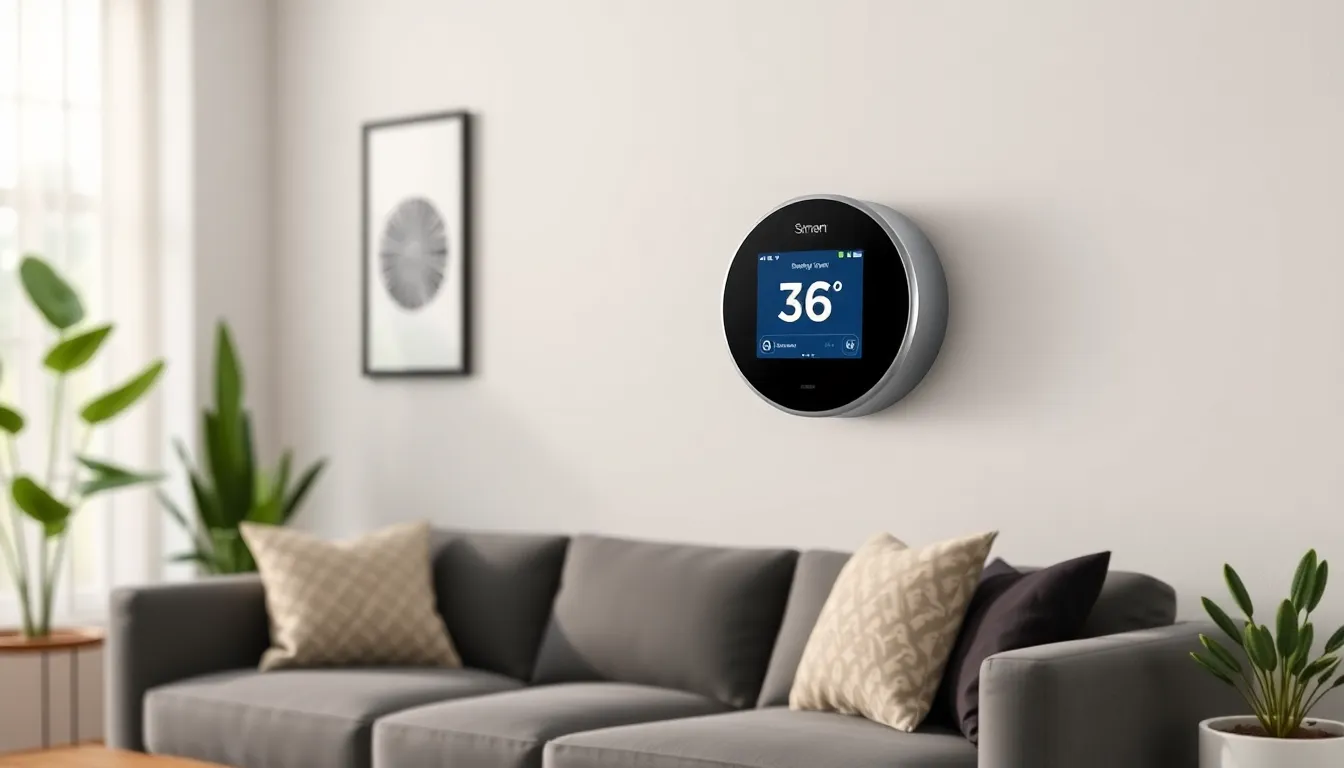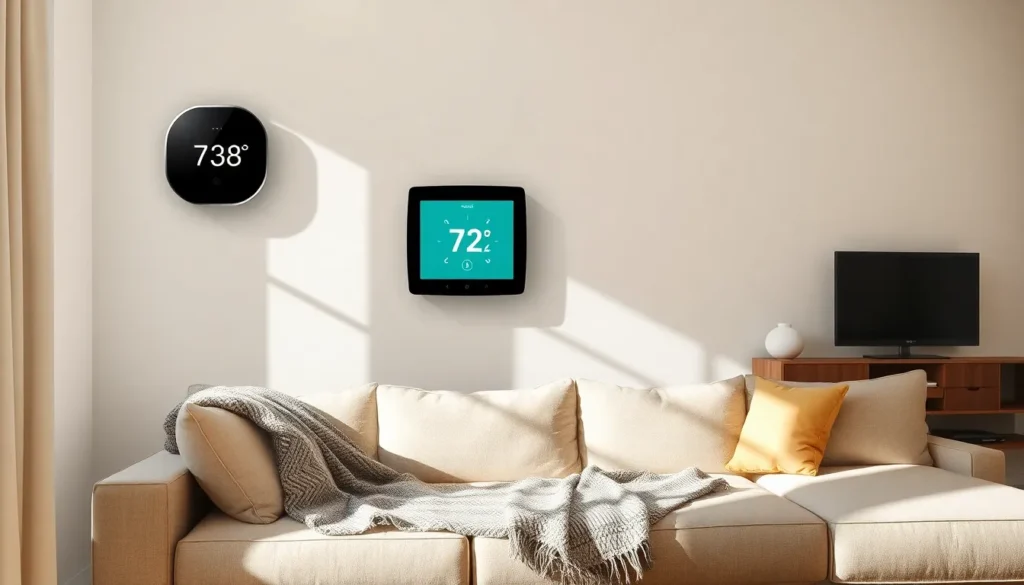Table of Contents
ToggleImagine coming home to a perfectly cozy house without lifting a finger. A smart thermostat makes that dream a reality. These clever gadgets not only learn your preferences but also adjust the temperature like a seasoned butler, ensuring you’re never too hot or too cold. Who needs a magic wand when you’ve got technology?
But it’s not just about comfort. Smart thermostats can save you money by optimizing energy usage. They’re like having a personal finance guru who also knows how to keep you warm in winter and cool in summer. With features like remote control and energy reports, they turn your home into a savvy, energy-efficient haven. So why settle for a regular thermostat when you can embrace the future and let a smart thermostat do the heavy lifting?
Overview Of Smart Thermostats
Smart thermostats significantly upgrade home temperature control by intelligently adjusting settings based on user behavior. They optimize energy consumption, enhance comfort, and provide convenient remote access.
Definition And Functionality
A smart thermostat is a device that learns user preferences and adjusts heating and cooling systems accordingly. It connects to the internet, allowing remote management through smartphones or tablets. These devices use sensors to measure current temperatures and can often report energy usage patterns, providing insights that help optimize efficiency. Smart thermostats integrate with home automation systems, enabling coordinated control with other smart devices.
Benefits Of Using Smart Thermostats
Energy savings rank as a top benefit, often reducing heating and cooling costs by 10 to 15 percent. User comfort improves as smart thermostats create tailored home environments based on individual habits. Remote access provides convenience; users can adjust settings from anywhere. Maintenance alerts notify users when systems require attention, enhancing longevity. Detailed energy reports help track usage trends, encouraging mindful consumption and supporting eco-friendly practices.
Key Features To Consider

Smart thermostats come equipped with various features that enhance comfort and efficiency. Evaluating these aspects can lead to a smarter choice.
Energy Efficiency
Energy efficiency serves as a primary consideration for smart thermostats. These devices typically reduce energy consumption by 10 to 15 percent, considerably lowering utility bills. They analyze user patterns and adjust heating and cooling schedules accordingly. Automatic adjustments in response to real-time data optimize energy use while maintaining comfort levels. The ability to generate energy reports empowers users to track their consumption habits. Understanding these patterns can drive more informed decisions regarding energy-saving strategies.
User Interface And Usability
User interface and usability play crucial roles in smart thermostat effectiveness. Intuitive designs allow for straightforward navigation, ensuring users can adjust settings with ease. Touchscreen displays provide clear access to thermostat controls and reports. Mobile applications enhance usability by enabling remote adjustments while users are away. Configuring schedules becomes seamless with guided prompts and tutorials. Accessible features cater to various user preferences, enhancing the overall experience.
Compatibility With Smart Home Devices
Compatibility with smart home devices significantly enhances thermostat functionality. Many smart thermostats integrate seamlessly with hubs and platforms like Amazon Alexa and Google Assistant. Such integration allows users to control home environments effortlessly through voice commands. Coordination with other smart devices can automate routines, such as adjusting temperature when detecting the user has left or arrived home. Selecting a thermostat that supports diverse ecosystems ensures flexibility and future-proofing in home automation.
Popular Smart Thermostat Models
Smart thermostats enhance home climate control through innovative technology. Various models on the market accommodate different needs and preferences.
Model Comparisons
Nest Learning Thermostat stands out with its adaptive learning ability. Ecobee SmartThermostat integrates sensors for room temperature management. Honeywell Home T9 prioritizes compatibility with multiple smart home systems. Each model offers unique features and capabilities that cater to various user requirements. Pricing varies, with options ranging from $100 to $250, reflecting technological advancements and features enclosed in each unit.
Pros And Cons Of Each Model
Nest Learning Thermostat excels in user-friendly design. Its downside is limited compatibility with specific HVAC systems. Ecobee SmartThermostat provides exceptional room sensors. However, installation might pose challenges for some users. Honeywell Home T9 appeals through robust smart home compatibility, but the app could use improvements. Weighing these pros and cons helps users select the most suitable model for their households.
Installation And Setup
Installing a smart thermostat can be accomplished through various methods, each offering unique advantages.
DIY Installation Options
DIY installation presents a cost-effective solution for tech-savvy homeowners. Smart thermostats generally come with clear instructions and all necessary tools for installation. First, one should turn off the power to the HVAC system to ensure safety during the installation process. Next, removing the existing thermostat involves detaching the cover and unscrewing the base plate. Once this is complete, the user connects the new thermostat wires to the corresponding terminals. After securely mounting the new device, restoring power allows for configuration via the mobile app. Many users appreciate the sense of accomplishment from completing the task themselves.
Professional Installation Services
In contrast, professional installation services provide convenience and expertise for those unfamiliar with electrical work. HVAC technicians possess the training to ensure proper installation and compatibility with existing heating and cooling systems. During an appointment, they assess the home’s setup to recommend the best thermostat features tailored to individual needs. This service typically includes a thorough walkthrough of the thermostat’s functions, which helps maximize user understanding. While professional installation may incur additional costs, it often guarantees optimal performance and minimizes the risk of potential issues.
Smart thermostats represent a significant advancement in home temperature control. By learning user preferences and optimizing energy consumption, they not only enhance comfort but also contribute to substantial savings on utility bills. With the ability to manage settings remotely and receive maintenance alerts, these devices simplify home management while promoting eco-friendly practices.
Choosing the right smart thermostat involves considering features like energy efficiency and compatibility with existing smart home systems. Whether opting for a DIY installation or professional setup, homeowners can enjoy the benefits of improved comfort and efficiency. Investing in a smart thermostat is a step toward a more sustainable and convenient living environment.







